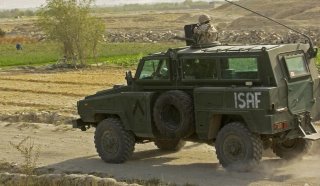 An energetic discussion on the issue of force protection for our troops in Iraq is being conducted on the unofficial Army forum, together with our own forum and a particularly pompous intervention from Mick Smith on his Times blog.
An energetic discussion on the issue of force protection for our troops in Iraq is being conducted on the unofficial Army forum, together with our own forum and a particularly pompous intervention from Mick Smith on his Times blog.The Smith piece is worth noting as it is a classic example of "clever-dickery", combining establishment thinking with know-it-all superiority, a condescending attitude and a basic lack of fundamental research, all with a complete failure to put the story in its broader political context.
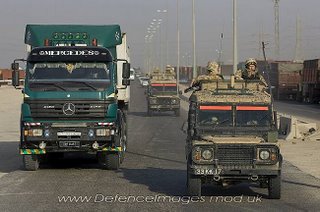 Headed, "too big for Basra" it takes on the themes which finally emerged in The Sunday Times yesterday, with the opening declaration that, "No-one should suggest or suspect that either Tony Blair or Gordon Brown wants British soldiers to die needlessly." Smith then adds, "The senior British Army officers who are trying desperately to find a solution to the problem certainly do not want soldiers to die needlessly."
Headed, "too big for Basra" it takes on the themes which finally emerged in The Sunday Times yesterday, with the opening declaration that, "No-one should suggest or suspect that either Tony Blair or Gordon Brown wants British soldiers to die needlessly." Smith then adds, "The senior British Army officers who are trying desperately to find a solution to the problem certainly do not want soldiers to die needlessly."That is the establishment line but, as has been rehearsed on our forum, the deaths arise in part as the consequences of decisions made by Tony Blair (and, one presumes, Gordon Brown). Whether they want soldiers "to die needlessly" is not the point. The fact is that some are and the reason is that money which should have been put urgently into devising counter-measures for IEDs is being spent on equipping a fantasy army for the European Rapid Reaction Force.
Similarly, although we can accept that "senior British Army officers" are "trying desperately to find a solution" – and we can certainly accept that they do not want soldiers to die needlessly – that again is not the point. Those senior officers, first and foremost, have to work within the budgetary constraints set by the MoD so their "desperation" is heavily qualified by the amount of money they have available.
Thus, when Smith then moves on to ask, rhetorically, "So why three years after the problems with IEDs first surfaced in Iraq are our troops still dying?", he has already conditioned the debate to exclude the main reasons for the situation.
Instead, we get a knowing but unsubstantiated assertion, combined with heroic name-dropping, with Smith recruiting Brigadier Bill Moore, Director Equipment Capability (Ground Manoeuvre), to his cause.
Moore is "in charge of the programme to get a new vehicle", and says the MoD had done "a significant amount" to improve the situation and “was continuing to try to do so”. I love that word, "significant" and use it all the time. It is the King of weasel-words because it implies "an awful lot" but is in fact meaningless. In fact, it actually means "not an awful lot", otherwise one calls a spade a spade, and says, "a great deal". But then, we know a great deal has not been done because troops are still patrolling in lightly armoured Land Rovers.
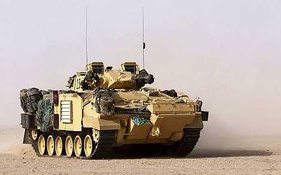 Then comes the spin. The "use of heavy armour had to be balanced with the need for soldiers to interact with local communities," says Moore. Yup… we agree. And if "Snatch" Land Rovers are too dangerous to use so you end up patrolling in Warriors and Challengers, for want of an intermediate vehicle like the RG-31, what price interacting with local communities, Mr Moore?
Then comes the spin. The "use of heavy armour had to be balanced with the need for soldiers to interact with local communities," says Moore. Yup… we agree. And if "Snatch" Land Rovers are too dangerous to use so you end up patrolling in Warriors and Challengers, for want of an intermediate vehicle like the RG-31, what price interacting with local communities, Mr Moore?But that question is neither posed nor answered. Instead, Brig. Moore argues that protection from threats (such as IEDs) is 30 percent equipment, 60 percent tactics, techniques and procedures and 10 percent luck. Again, this is more weasel words. For sure, avoidance of IEDs requires that mix – although the precise mix ratios can be argued over – but when all that has been accounted for, and an IED goes off next to a vehicle, whether the occupants survive is 100 percent equipment.
Nevertheless, Moore claims that, "We work constantly to ensure that our tactics, techniques, procedures and equipment meet the demands of the operational environment. We have done a significant amount to enhance existing equipment and continue to do so."
But that is a matter of opinion, and Moore does not substantiate his claims. As I point out on the Unofficial Army forum, a successful counterinsurgency strategy is more than a question of improved armour for patrol vehicles. Looking at the measures available, I argue that the vital role of humint (human intelligence) could be enhanced. We know that the Army has cut down on language courses for troops being deployed to Iraq, but we definitely need more native language speakers. There could be more funding for informers and rewards and even such incentives as offering British citizenship and an emigration package to those informers who put themselves in harms way to assist HMG.
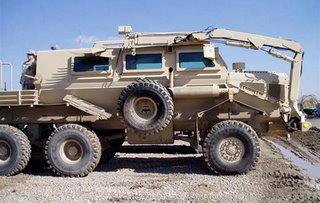 In terms of terms of technical countermeasures, we need greater use of UAVs – which are very limited in the British sector, but which the US are exploiting with great success. On the horizon are techniques like "environmental exception mapping", using computer-aided analysis to compare "before and after" video films taken by UAVs, to pick up things like disturbed soil by the side of a road, which might indicate that a bomb has been hidden there. Then there is an urgent need for more light helicopters, the current fleet of Lynxes being described as "knackered" and far too few in number. Then we could certainly employ vehicles such as the Buffalo and Cougar to hunt out IEDs.
In terms of terms of technical countermeasures, we need greater use of UAVs – which are very limited in the British sector, but which the US are exploiting with great success. On the horizon are techniques like "environmental exception mapping", using computer-aided analysis to compare "before and after" video films taken by UAVs, to pick up things like disturbed soil by the side of a road, which might indicate that a bomb has been hidden there. Then there is an urgent need for more light helicopters, the current fleet of Lynxes being described as "knackered" and far too few in number. Then we could certainly employ vehicles such as the Buffalo and Cougar to hunt out IEDs.Yet, as far as we know – and we know a great deal – nothing like this is happening in the British occupied sectors.
But finally, Mick Smith down get down to money, but in a mealy-mouthed way. We have an RAF Chief of Defence Staff, he writes:
Air Chief Marshal Sir Jock Stirrup is a good man but I wonder how he would defend the cost of the RAF’s expensive Eurofighter/Typhoon aircraft, large numbers of which we don’t need, alongside the amount of money allocated to Moore to try to sort out the problem of the inadequate armour protection on the Snatch Land Rover.But then comes yet more spin. "The simple truth," adds Smith:
…is that putting a large amount of armour on a small vehicle is extremely difficult. The British Army looked at a number of different options, including the Nyala RG-31, a South African mine-protected vehicle produced by BAE Systems. Ministers say that – at just 50 cms wider than the Snatch Land Rover - it is not manoeuverable enough to be used in the streets of Basra, has then wrong profile for peacekeeping and that an earlier version was used before by the British Army in Bosnia where it proved to have maintenance problems.The "route proving" bit is wrong, and so is the comment about "maintenance problems", but never mind.
The army used it in Bosnia for "route-proving", quite literally going out in front of a convoy and using the safety of its protective armour to ensure that there were no landmines on the route. The "maintenance problems" were in fact caused solely by attempts to put heavier armour on it. The engine and suspension couldn't cope with the extra weight.
Smith then remarks that the Canadians have bought the RG-31 for use in Afghanistan but, strangely, does not mention that the US has bought 148 for use in Iraq for protection against IEDs. "Ministers still defend the decision not to go for the RG-31," he then tells us, "It might have proven effective against land mines. It might be good enough for the Canadians. You might even be able to get it on the ground very quickly. But its profile is all wrong and it's just that bit too big for Basra."
That is the impression we are left with… "it's just that bit too big for Basra." But, of course, the Warriors and Challengers are not – and they really do have the right profile, don't they.
Now, as we reported quickly, earlier today, the secretary of state for defence, Des Browne has stated that he has asked for a review of the Land Rover question. For once, Tory MPs have done their stuff, Roger Gale MP having demanded in defence questions to know what vehicles are being considered to replace them.
With success possibly on the horizon though, now is the time to step up the pressure, not least to make sure the right decision is made. As Smith points out in his piece:
Earlier this year, as the British prepared to deploy to Afghanistan's southern Helmand province, the Taliban began copying the insurgents in Iraq using the same sort of IEDs. The need for a vehicle that had improved armour protection above that afforded by the Snatch Land Rover became increasingly urgent and ministers agreed to pay £35m for 80 armoured Pinzgauer Vectors as part of an "Urgent Operational Requirement".
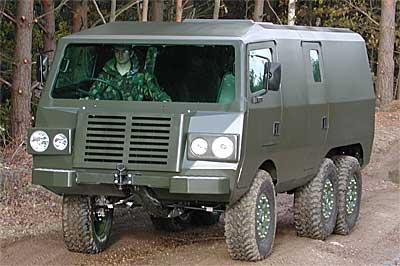 This is where Smith displays his ignorance and lack of research. The Pinzgauer is not a patrol vehicle but a 14-seat troop transport.
This is where Smith displays his ignorance and lack of research. The Pinzgauer is not a patrol vehicle but a 14-seat troop transport.Furthermore, the level of protection is no greater than the "Snatch" and, with its slab sides and flat floor, it is not a mine protected vehicle. It is described as being designed "to withstand two NATO L2A2 hand grenades detonating simultaneously only 150mm below the floor pan. These grenades would normally carry a lethality radius of 5 metres." Compare and contrast the RG-31 specification, which can withstand the equivalent of two anti-tank mines exploding simultaneously under any wheel – 14Kg of TNT - or 7Kg under the cabin.
In March of this year, 14 US Marines and a civilian interpreter were killed when their amphibious assault vehicle struck an IED about a mile south of Haditha, Iraq. The "Amtrak", as it is known, affords a level of protection similar to the armoured Pinzgauer. And one feature of these lightly protected vehicles is that an IED may penetrate one wall but not have the force to break through the second, the armoured enclosure thus containing the blast with fatal consequences to all the occupants.
These Pinzgauers, far from making troops safer, could end up being "coffins on wheels". When it comes to new patrol vehicles for Iraq, therefore, the MoD cannot be trusted to make the right decision. The battle must continue.